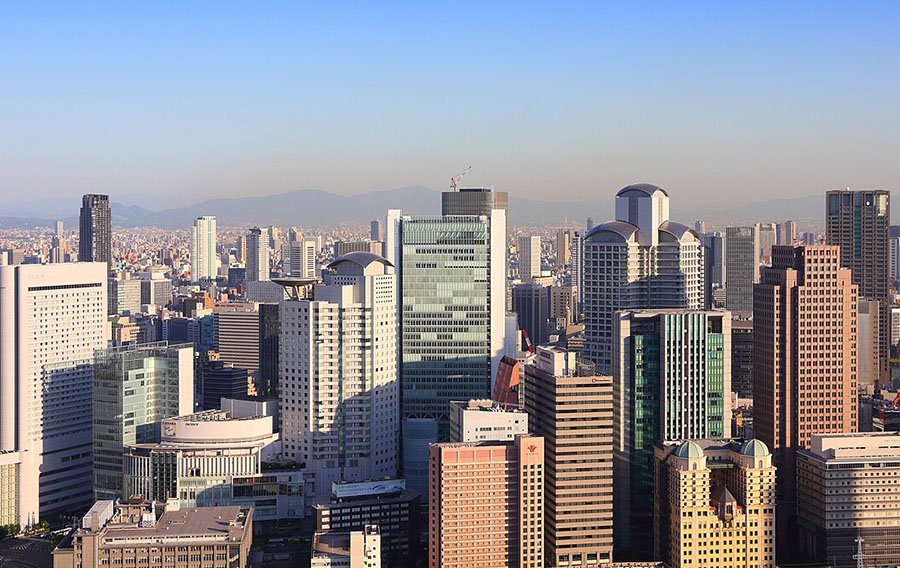The Healthiest and Most Comfortable Cities in Europe: HUDI-2025 Ranking

Photo: Unsplash
The research center ISGlobal evaluated the quality of the urban environment and the factors influencing residents’ health in 917 European cities. The study revealed that the most comfortable living conditions are formed in compact, mid-sized municipalities rather than in megacities or tiny settlements. The leaders are Pamplona (Spain), Geneva (Switzerland), and Harlow (United Kingdom).
The HUDI Index is based on 13 indicators grouped into four categories: transport and mobility, density and urban structure, air quality, and green areas and climate resilience. Each category was scored from 0 to 10, after which analysts formed the overall index. Differences in settlement size were also taken into account, as they directly affect living conditions.
The Largest Cities
Among Europe’s largest agglomerations with populations over 1.5 million, Madrid ranked first with 6.04 points. The Spanish capital demonstrates a rare combination for a megacity: dense street layout and advanced public transport, where the metro and pedestrian zones partly offset the high level of air pollution. In recent years, the city has actively limited private car use, expanding electric-bus fleets and car-free districts.
Second place goes to Barcelona (5.67), where the ideal Eixample grid ensures walkability and sustainable mobility. However, the high building density and shortage of green zones keep the city below the six-point mark. Vienna (5.29) ranks third — one of Europe’s most efficiently organized metropolises. Effective transport and energy-efficient architecture coexist with dense historic buildings, leaving central districts short of recreational space.
Next is Rome (5.08): the Italian capital benefits from a mild climate and a compact center but loses points for heavy traffic congestion. London (5.01) follows in fifth place, where high nitrogen-dioxide levels still reduce the overall index despite massive investments in transport electrification.
Paris (5.01) remains a city of contrasts: a powerful transport system and strict car-restriction policies do not compensate for chronic air pollution. The top ten also include Budapest (4.89), Berlin (4.72), Bucharest (4.68), and Warsaw (4.32). These cities show solid progress in public-transport development but suffer from a lack of green areas and heat-island effects — a common issue for Eastern European megacities.
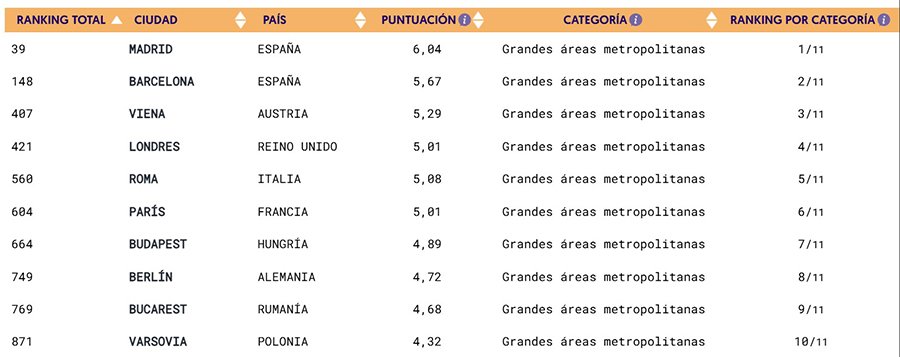
Mid-Sized Metropolises
Among cities with 500,000 to 1.5 million residents, Lisbon leads with 6.09 points. The Portuguese capital maintains a rare balance between historic architecture and modern mobility: about 80% of the population lives within a ten-minute walk of a park or boulevard, while the hilly terrain supports natural ventilation and reduces pollution.
Stockholm (5.96) ranks second as one of Europe’s greenest capitals. Almost all public transport has been electrified, and green areas cover about a third of the city’s territory. Athens (5.86) takes third place; despite the hot climate and challenging terrain, the Greek capital has made progress in developing waterfronts and networks of public spaces.
Glasgow (5.79) climbed to fourth thanks to major brownfield-renovation projects and better access to green districts. Seville (5.76) completes the top five — a city where walking routes and cycling infrastructure have become part of its identity.
The top ten also include Birmingham, Manchester, Copenhagen, Dublin, and Sheffield. British cities are gradually regaining balance between density and ecology. Copenhagen and Dublin perform steadily in sustainable transport and building energy efficiency. All these urban centers share moderate density, high greenery levels, and pedestrian-oriented planning — parameters that HUDI associates with better quality of urban life.
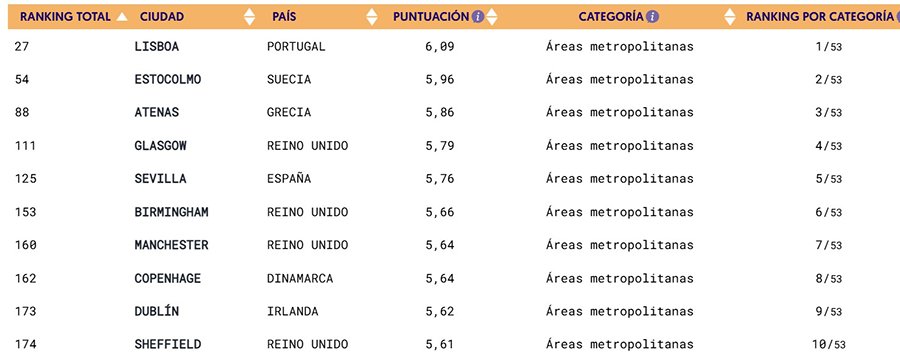
From Bilbao to Bolton
Among cities with 200,000–500,000 residents, Bilbao (6.35) achieved the best results. The former industrial hub of Spain has become an example of how to combine dense urban structure, green areas, and sustainable mobility. Integrating bike lanes into public-transport systems and redeveloping industrial zones allowed the city to reach a high level of environmental stability.
La Coruña (6.14) ranks second, with urban planning closely tied to the coastal zone. The city is developing promenades and pedestrian routes, while wind-energy use helps maintain a favorable environment. Edinburgh (6.10) and Southampton (6.10) share third and fourth positions — the former notable for nearly universal park access within a ten-minute walk, the latter for clean air and active creation of public spaces.
Fifth is Móstoles (6.08), a satellite of Madrid that preserved its compactness and green infrastructure despite rapid housing growth. Next comes Granada (6.06), where downtown improvements and new bike lanes have made it one of Andalusia’s most comfortable cities.
Porto (5.99) is recognized for efficient transport and abundant public spaces. The top ten also include Milton Keynes, Dudley, and Plymouth — British cities distinguished by greenery and well-designed walking networks. Just beyond them, but still in the top 15, are Florence and Northampton (5.94 each), Tameside (5.93), Newcastle upon Tyne (5.90), and Bolton (5.87).
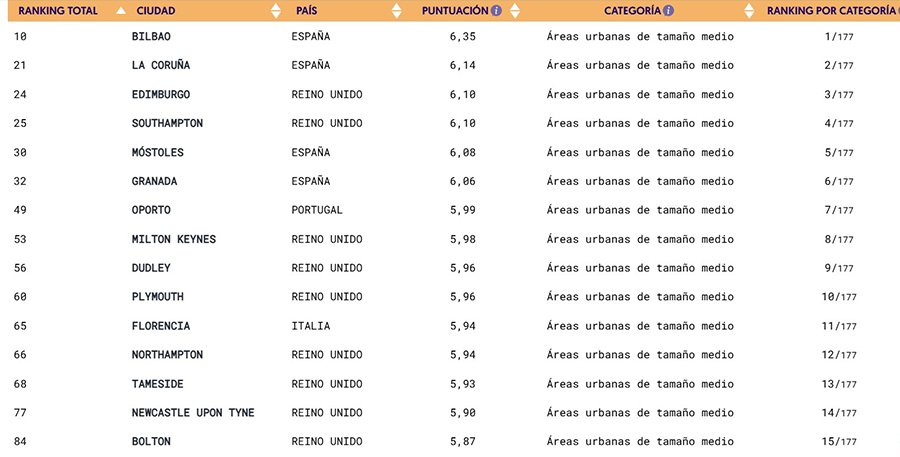
Small-City Leaders
The overall winners were small cities with 50,000–200,000 residents. The absolute leader in Europe is Pamplona (6.80), the compact capital of Spain’s Navarre region. It is recognized as a model of balanced urban design: dense development, extensive cycling routes, and nearly universal pedestrian coverage earned it the top score. Over 90% of residents live within a ten-minute walk of a park, and air-pollution levels are among the lowest on the continent.
Geneva (6.65) ranks second, combining strong business activity with exceptional greenery — over 50 sq. m of green areas per person, accessible to nearly all inhabitants. Third is Harlow (6.64), a British “garden city” confirming the success of that concept. Separated traffic flows, numerous public spaces, and an extensive pedestrian network make it a model of compact and healthy urbanism.
Fourth is San Sebastián (6.51), where the coastal setting and thoughtful layout create comfort for both residents and tourists. Stevenage (6.46) and Majadahonda (6.38) follow, both demonstrating high transport connectivity and well-maintained public realms.
Crawley, Parla, and Santa Coloma de Gramenet (6.37 each) share the next spots, maintaining strong scores in greenery density and walkability. Completing the top 10 is Castelldefels (6.32), a Catalonian resort city that preserved ecological balance through low-rise planning and proximity to the sea. High results were also recorded for Ioannina (6.27), Exeter (6.26), Amadora (6.24), Luxembourg (6.20), and Girona (6.18).
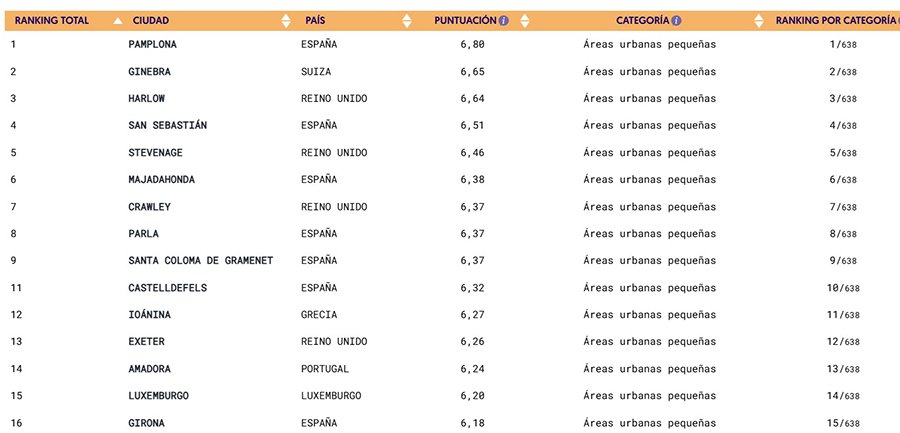
Small Municipalities
In the category of very small municipalities (under 50,000 residents), Campobasso (6.02) leads — a regional center in southern Italy proving that even small towns can be comfortable. Second is Ibiza (5.47), where natural potential and climate offset high seasonal pressure. Despite its tourism profile, the town maintains compactness and park access.
Third place goes to Przemyśl (5.35) in Poland — a city with a preserved historic core and developed public infrastructure, maintaining pedestrian routes and a dense street grid. Next come Santurce (5.32) and Igualada (5.18), both Spanish cities promoting sustainable principles such as reduced car traffic, renewed centers, and emphasis on community spaces.
Sixth is Limerick (5.10), showing good results in urban amenities and air quality. Mislata (5.09) and Zamość (5.04) prove that dense historic layouts can successfully adapt to modern environmental standards. The top 10 concludes with Karlovy Vary (4.87) and Passau (4.84) — spa towns whose natural environment remains their key advantage, though building and transport limits constrain their scores.
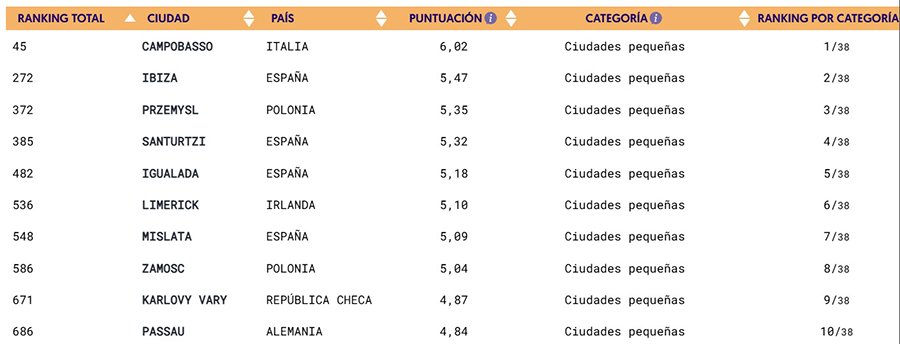
Conclusion
HUDI-2025 highlights gradual changes in European urbanism. The gap between large capitals and medium-sized cities is narrowing. Megacities are adopting greener standards and reforming transport systems, while mid-scale centers are strengthening their economies and infrastructure.
For smaller cities, the challenge is tougher — to preserve the advantages of compactness without losing dynamism. Limited resources and transport isolation often prevent them from reaching the level of more developed municipalities.
The study shows that Europe’s comfortable urban environments no longer follow a single model. Each city maintains its own balance between economy, density, and ecology — and this diversity makes the map of sustainable development truly multilayered.
Read more:
Best Cities in the World to Live in 2025
How Digital Nomads Are Transforming Cities and Economies
Migrant Integration Index 2025: Europe Is Losing Momentum
Where Is the Best Place to Retire: Global Citizen Solutions Report
The Largest and Smallest Countries in the World: Britannica Ranking








